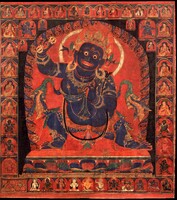Wrathful Vajrapani - Jeweled Crown or Skull Crown?

In the Sutra tradition of Mahayana Buddhism the bodhisattva Vajrapani is regarded as one of the Eight Heart-sons of Shakyamuni Buddha and portrayed in a peaceful appearance. In the tradition of Vajrayana Buddhism, Vajrapani is typically shown in a wrathful form and further known as Guhyapati - 'the Lord of Secrets.' Historically he is the main recipient, holder and protector of all the Tantra texts and teachings received from the Buddha Shakyamuni (in the appearance of Vajradhara). From the model of the Lower Tantras Vajrapani symbolizes the body of all buddhas of the ten directions and three times and represents enlightened activity. The bodhisattva Manjushri represents mind and Avalokiteshvara that of speech. In Tantric practice Vajrapani is a meditational deity, a Buddha, with numerous forms found in all of the four levels of Tantra classification and popular in all traditions of Tibetan Buddhism - new and old.
The two wrathful forms of Vajrapani known as the Sutra Tradition (do lug) and the Nilambhara (dro zang lug) generally do not have skull crowns or wrathful ornaments such as the fifty freshly severed heads. Mahachakra Vajrapani is sometimes depicted with a skull crown and at other times shown with a jeweled crown. They do however wear the eight races of nagas depicted as snakes - bracelets, anklets, etc. Almost all of the other wrathful forms of Vajrapani have the same fearsome regalia as typical of wrathful Tantric deities such as Vajrabhairava, Vajrakila, Mahakala and the like.
